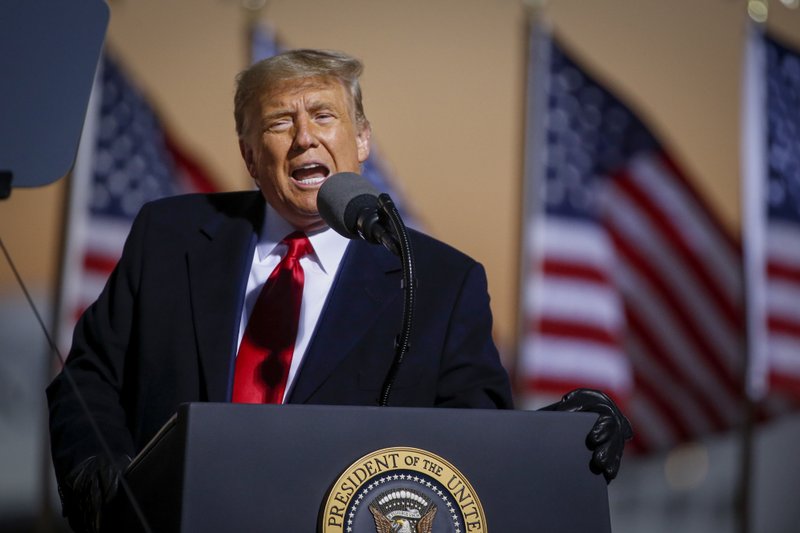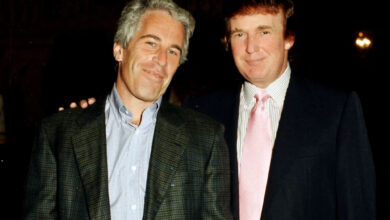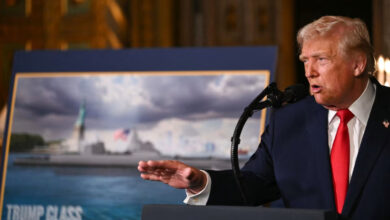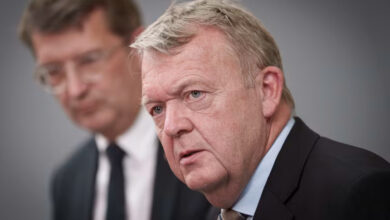
Expect to see a lot more of the same if there’s a second Trump administration.
President Donald Trump has consistently pointed to tax cuts and regulatory relief as key successes of his first four years in office. He has repeatedly pushed for the end of the Obama-era health law but has yet to deliver a plan to replace it. And he has spent most of this year defending his response to the coronavirus pandemic while fighting openly with scientists and medical experts about vaccines, treatments and more.
If he gets another four years in office, there’s no indication of any big policy shift.
A glimpse at how a second Trump term might look:
___
ECONOMY, TAXES AND THE DEBT
Low unemployment and a soaring stock market were Trump’s calling cards before the pandemic. While the stock market clawed its way back after cratering in the early weeks of the crisis, unemployment stands at 7.9 percent, and the nearly 10 million jobs that remain lost since the pandemic began exceed the number that the nation shed during the entire 2008-09 Great Recession.
And by Friday, Wall Street had closed out another punishing week with the S&P 500 posting its first back-to-back monthly loss since the pandemic first gripped the economy in March. Much of the market’s focus has been on what’s to come for the economy when coronavirus counts are rising at troubling rates across Europe and the United States.
Trump has predicted that the US economy will rebound in late 2020 and take off like a “rocket ship” in 2021. He promises that a coronavirus vaccine or effective therapeutics will soon be available, allowing life to get back to normal. His push for a payroll tax cut over the summer was thwarted by stiff bipartisan opposition. But winning a second term — and a mandate from voters — could help him resurrect the idea.
An analysis from the Committee for a Responsible Federal Budget estimates that Trump’s plan would increase the debt by about $5 trillion over 10 years. That’s on top of the $13 trillion in deficits the country is already expected to run up during that time.
The national debt now stands at more than $20 trillion.
___
CORONAVIRUS PANDEMIC
Trump insists that the country is “rounding the corner” on the pandemic and has stepped up calls on Democratic governors to lift coronavirus restrictions in their states. But Trump’s sunny outlook belies the ground truth in many states — including several critical to his path to 270 Electoral College votes — that have seen a surge in the virus.
The president has often disputed medical experts in his own administration, among them infectious disease expert Dr. Anthony Fauci, on key issues surrounding the virus, including the timing of a vaccine, the need for social distancing and the importance of masks to contain the virus. His campaign rallies were filled with people gathered less than 6 feet apart without masks. His announcement of the nomination of Amy Coney Barrett to the Supreme Court was widely regarded to be a super spreader event after he and several other people in attendance were diagnosed with the virus.
Trump spent three days at Walter Reed National Medical Center after his diagnosis. One of the drugs he received, remdesivir, has since been approved by the Food and Drug Administration for treatment of COVID-19.
Trump also says he’s “pretty damn certain” that vaccines and new treatments for the virus are coming in the not-so-distant future. Scientists are more cautious about the timing.
Congress passed and Trump signed into law a more than $2 trillion coronavirus relief package earlier this year, but the two sides have been unable to agree on an additional aid package.
___
HEALTH CARE
As a candidate for the White House, Trump promised that he would “immediately” replace former President Barack Obama’s health care law with a plan of his own that would provide “insurance for everybody” with lower costs. Americans are still waiting for a pan that Trump has been teasing for many months.
He may be counting on the Supreme Court, which is scheduled to hear a case challenging “Obamacare” soon after the election. The court now has a solid conservative majority with the confirmation of Barrett as a justice.
Trump officials say the administration has made strides by championing transparency on hospital prices, pursuing a range of actions to curb prescription drug costs and expanding lower-cost health insurance alternatives for small businesses and individuals. But those incremental steps fall far short of the sweeping changes he promised.
The number of uninsured people has gone up on Trump’s watch, from 27.6 million people under age 65 in 2017 to 29.2 million last year, according to the nonpartisan Kaiser Family Foundation. There are no solid statistics on uninsured Americans this year, after millions lost job-related coverage in the pandemic.
On prescription drugs, Trump came into office promising change so Americans would see the lower costs common in other economically advanced countries. But he backed away from a 2016 campaign promise to authorize Medicare to negotiate prices. And a big, bipartisan deal with Congress to reduce costs for Medicare recipients and restrain price increases eluded him.
His administration did reach a narrower, yet significant agreement with drug companies and insurers to limit out-of-pocket costs for insulin for seniors to $35 a month. A series of regulations to try to curb drug costs remains a work in progress.
___
IMMIGRATION
Trump worked through his first term to sharply curtail both legal and illegal immigration. Expect that to continue if he wins a second term.
One of his top priorities would be to use agreements with Central American governments as models to get countries around the world to field asylum claims from people seeking refuge in the United States, a top adviser, Stephen Miller, recently told The Associated Press. He said the agreements would help stop “asylum fraud, asylum shopping and asylum abuse on a global scale.”
Miller also forecast a broader offensive against so-called “sanctuary” jurisdictions that limit cooperation with federal immigration authorities, saying the administration would use its “full power, resources and authority.” He vowed more efforts toward legal immigration “based on merit.”
Trump’s pledge to build a wall along the U.S border with Mexico was a hallmark of his first presidential campaign and four years in office. Trump is expected to continue to trumpet progress after having completed nearly 400 miles of wall construction, though most of that replaced existing smaller barriers.
Trump has yet to outline second-term immigration priorities in detail, though he has openly toyed with trying to repeal a constitutional right to citizenship for anyone born in the United States.
His administration has long pursued a zero-tolerance policy to crack down on illegal immigration, and thousands of children were separated from their parents after crossing the border illegally. The administration was roundly criticized for its actions.
Administration officials also sought to restrict legal immigration, including higher fees and increased scrutiny for people seeking to legally emigrate to the US The administration slashed the number of refugees allowed in the country by about three-quarters to its lowest level in decades.
Trump has also sought to end Deferred Action for Childhood Arrivals, or DACA, a program that allowed people brought to the United States illegally as children to remain as legal residents, though his effort was halted, at least temporarily, by the courts.
___
FOREIGN POLICY AND NATIONAL SECURITY
Trump’s foreign policy centers on his mantra of “America First,” but in the months leading up to the election, he engaged in diplomacy.
The Trump administration scored a big win in recent weeks by nudging three Arab states — Bahrain, Sudan and the United Arab Emirates — to normalize relations with Israel. Trump officials also brokered an economic cooperation agreement between Serbia and Kosovo, bitter foes in the Balkan wars.
He counts as another major achievement his efforts to cajole more NATO members to fulfill their pledge to spend 2 percent of their gross domestic product on defense.
Trump also pulled the US out of the Iran nuclear deal, saying it was one-sided in favor of Iran. He’s announced that the US is withdrawing from the intermediate-range nuclear missile treaty with Russia and the Open Skies Treaty, which permits 30-plus nations to conduct observation flights over each other’s territory. He later said he might reconsider pulling out of that treaty.
The president has reduced to about 3,000 the number of troops in Iraq. The US plans to reduce the number of troops in Afghanistan to at least 4,500 in November, although Trump wants them all withdrawn by the end of the year. He also counts his engagement with North Korea’s Kim Jong Un as a foreign policy victory, yet he’s been unable to prod Kim to give up his nuclear program.
___
PUBLIC HEALTH AND ENVIRONMENT
A Trump second term would begin to see a US transformed by the scores of public health and environment rollbacks in Trump’s first term, when the administration weakened protections in landmark pollution laws that had stood for a half-century.
Trump’s biggest environmental rollbacks include removing federal protections for millions of miles of wetlands and waterways. That means mining companies and other industries will be freer to dump waste into the fragile habitats or destroy them outright, removing buffers against storms and flooding and making it harder for cities downstream to clean public water supplies, environmental groups say.
Another major rollback means neighborhoods nationwide will find themselves having less say about highways or other big projects tearing through their communities. Other rollbacks enacted in Trump’s first term — in regulations ranging from endangered species to oil and gas and mining in federal wilderness to power plant pollution to water-thrifty dishwashers — will take effect.
On climate change, Trump’s withdrawal of the United States from the Paris global climate accord would become official Nov. 4, the day after the presidential election. Trump is still fighting California and other Western states over his plans to ease future vehicle mileage standards, undoing another legacy climate effort of the Obama administration.
A Supreme Court made more conservative by Trump’s appointments will decide pending court challenges by states and environmental groups to many of the rollbacks.
The Trump administration says it wants to focus on helping minority communities that are disproportionately harmed by polluting industries in a second term. Environmental groups point to the administration’s efforts to slash funding for such programs, and call it an empty election-year promise.
___
EDUCATION
Trump believes that a key to economic recovery from the virus is fully reopening schools, though Americans are wary. Only about 1 in 10 think day care centers, preschools or K-12 schools should open this fall without restrictions, according to a recent poll by The Associated Press-NORC Center for Public Affairs.
He is calling for the expansion of charter schools and school choice programs, including a proposed tax credit for people who contribute to scholarships sending students to private schools and other education options. Under his watch, the federal government has also increased funding for historically Black colleges and universities — an effort he often cites as one of the things he has achieved for Black Americans.
Trump frequently rails against what he has described as “radical left indoctrination” in schools. He is pledging to create a commission to promote “patriotic education” in schools. Amid complaints that conservative voices are stifled on college campuses, he also sought to cut federal funding to colleges that do not protect speech rights.
Trump’s administration has revoked several Obama-era initiatives, including guidance intended to curb racial disparities in school discipline and a rule that sought to cut federal funding to for-profit colleges that left students with heavy debt.
The Education Department under Trump has also created rules telling schools and universities how to respond to sexual misconduct, with more protection for the accused.
___
ABORTION
Before becoming a presidential candidate, Trump described himself as a strong abortion-rights proponent. But after coming to Washington, he pushed for overturning Roe v. Wade, the Supreme Court ruling that 47 years ago established a constitutional right to abortion.
Anti-abortion groups hope the addition of Barrett to the Supreme Court will provide a majority to overturn Roe. Barrett has declined to characterize Roe as a “super-precedent” that must not be overturned, although she says that she sets her personal views aside when weighing cases.
Trump also has barred federally funded family planning clinics from referring women for abortions. He supports the Hyde Amendment, a series of federal laws that ban the use of taxpayer money to pay for abortions except in cases of rape or incest or to save the woman’s life.
___
SOCIAL SECURITY
Even before the coronavirus shutdown sent the economy on a roller coaster ride, government experts estimated that Social Security would be unable to pay full benefits starting in 2035. The program’s insolvency date is now likely closer than that, because layoffs have cut into Social Security tax collections from workers and employers.
Trump kept his promise not to cut Social Security benefits, but this summer he sent confusing signals with a plan to temporarily suspend collection of certain taxes that fund the program. While the White House staff said it was a limited measure that would have no lasting impact, Trump kept hinting to reporters that he had much bigger tax cuts in mind. Early in the year, he told an interviewer he wanted to tackle “entitlements,” or benefit programs, in a second term.
___
GUNS
Trump has flirted at times with tighter gun laws. After the Parkland school shooting in Florida two years ago, Trump chided Republican lawmakers for being too “scared” of the National Rifle Association to tighten gun laws. And after back-to-back mass shootings in Ohio and Texas in 2019, he embraced calls for “strong background checks.” He backpedaled quickly in each instance.
In the campaign, the president has repeatedly promised to “defend our Second Amendment.” The NRA’s political action committee has endorsed Trump.
___
VETERANS
Trump frequently touts an expanded program at the Department of Veterans Affairs passed by Congress in 2018 that allows veterans to choose a private physician outside of the government-run VA system and still receive taxpayer-paid medical care.
The program, first passed as a temporary measure during the Obama administration, was spurred by a 2014 scandal in which veterans died while waiting months for appointments at the Phoenix VA medical center. Trump supports giving veterans wide access to private-sector care if they are dissatisfied with VA treatment, and he has suggested he may issue additional regulations in a second term that will make it even easier.
Trump has boosted telehealth services at the VA and broadly promises an improved US economy in a second term that will reduce veterans’ unemployment. He created a federal task force last year to address veterans suicide. In October, he signed into law a bipartisan bill that creates a new three-digit 988 phone line — similar to 911 — that will be reserved for mental health emergencies. It becomes active in fall 2021.
About 20 veterans die by suicide each day, a rate basically unchanged during the Trump administration.
___
TRADE
Trump views the signing of two major trade deals — an updated pact with Mexico and Canada and the first phase of a China agreement — as signature achievements. The US and China signed in January, less than two months before the pandemic put an enormous strain on US-China relations. Trump says the first phase would lead to China buying roughly $200 billion over two years in US agricultural products, energy and other American products.
In return, the US canceled or reduced tariffs on an array of China imports. So far, China is significantly behind in meeting its purchasing commitments, according to tracking from the Peterson Institute for International Economics.
The second phase of the deal is expected to focus on tougher issues between the countries, including Trump’s wish to get China to stop subsidizing its state-owned enterprises. But for Trump, who has come to frequently refer to the coronavirus as the “China virus,” it remains to be seen whether he will be able to effectively reengage Beijing on trade. Trump recently said he’s “not interested” in talking to China.
___
Associated Press writers Kevin Freking, Ricardo Alonso-Zaldivar, Ben Fox, Deb Riechmann, Collin Binkley and Hope Yen contributed to this report.
Image: President Donald Trump speaks at a campaign rally Friday, Oct. 30, 2020, in Rochester, Minn. (AP Photo/Bruce Kluckhohn)




